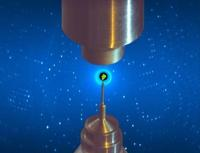Speakers
Description
The major iron uptake mechanism in bacteria is mediated by ABC transporters of the FutA type. We study iron uptake and homeostasis in highly adapted marine cyano-bacteria that are of high geochemical significance for global net carbon fixation. We study FutA substrate binding domains that bind iron in the Fe(III) oxidation state. FutA proteins also have an intracellular function in protection against photo-oxidative stress, then binding iron in the Fe(II) oxidation state.
Observation of iron complexes in X-ray crystallography is hampered by photoreduction of ferric Fe(III) to ferrous Fe(II), complicating study of the iron binding mechanism. We characterised photoreduction at room and cryogenic temperatures using dose-controlled X-ray crystallographic experiments and used single crystal, multi-crystal and serial crystallography data collection strategies with rotating anode, synchrotron or XFEL sources.
While the XFEL experiment serves as a “zero dose” reference point, we compare this experiment to a neutron diffraction experiment that avoids inherent photoreduction. The neutron experiment gives additional information and derives the protonation state of amino acids involved in metal coordination. Neutron diffraction data collection was carried out at BIODIFF using a single fully deuterated crystal sample produced by buffer exchange. Together with the X-ray crystallographic structures we can now define switches that allow FutA to bind Fe(III) and Fe(II) iron species.

